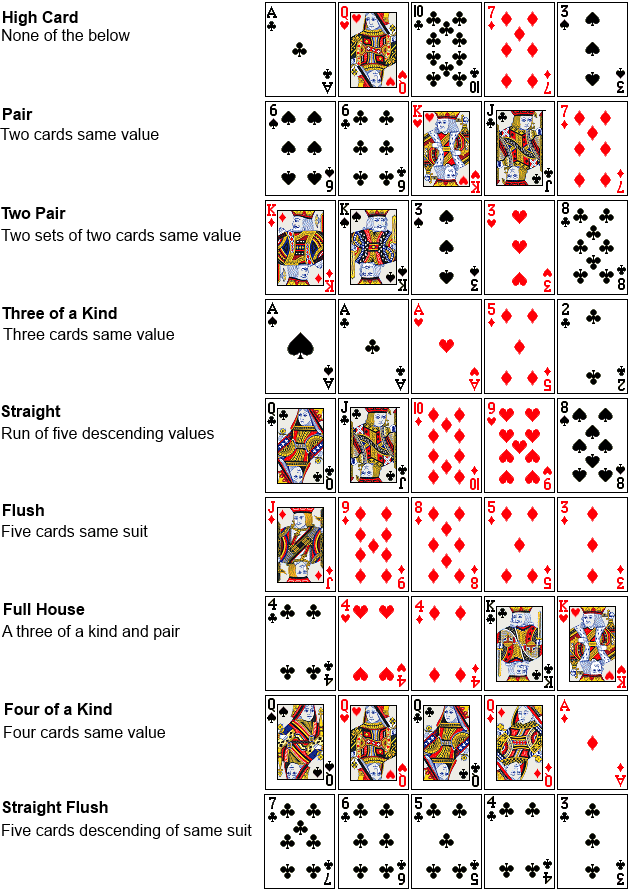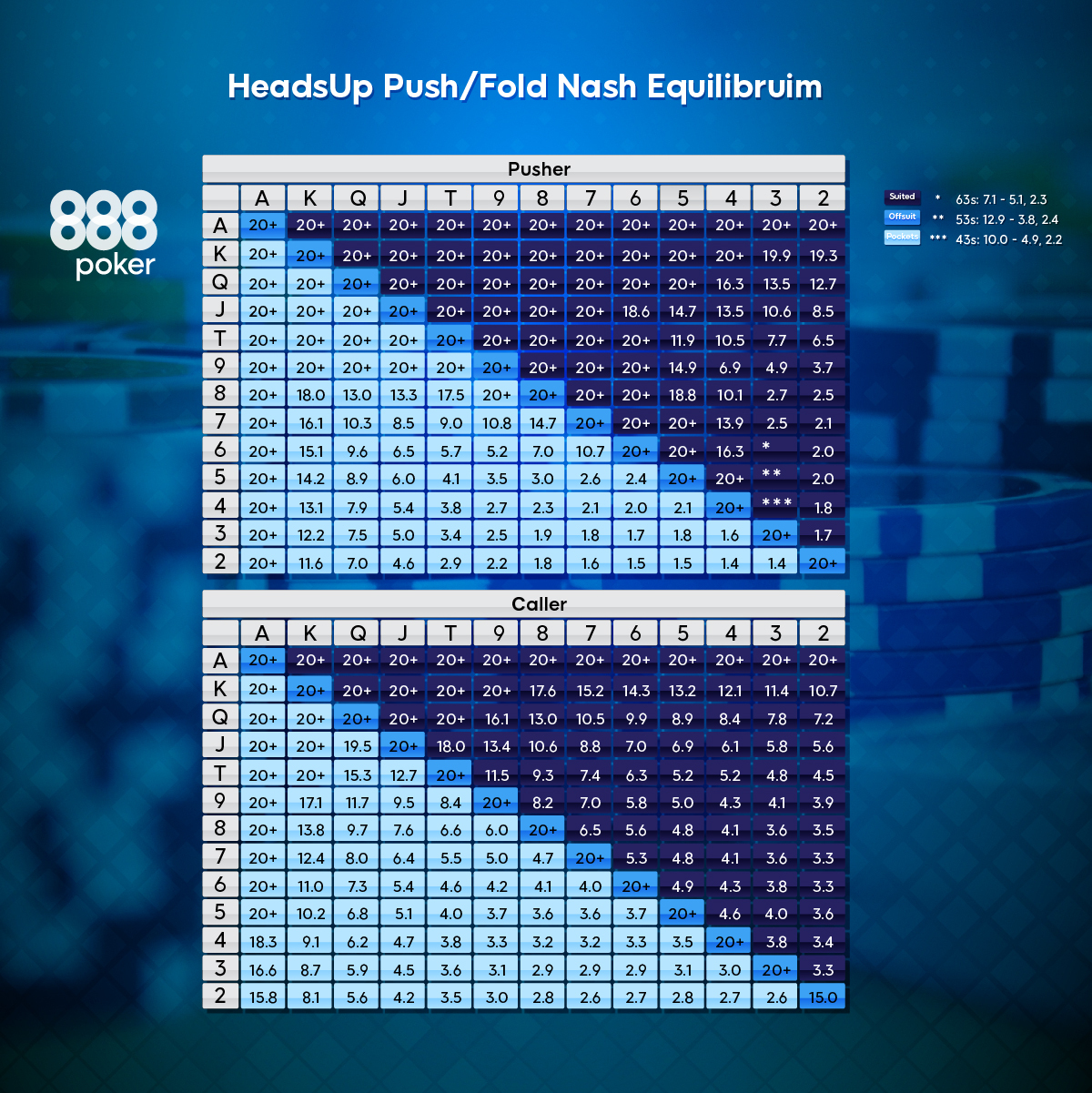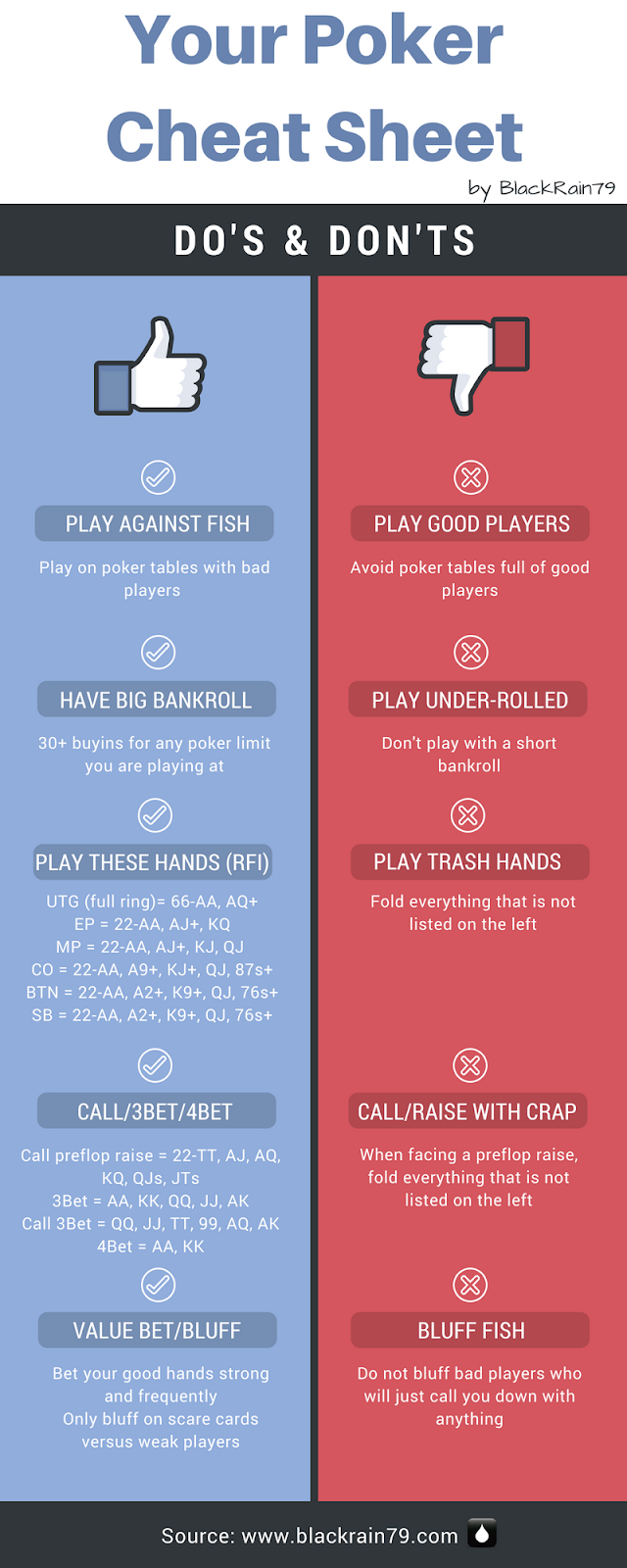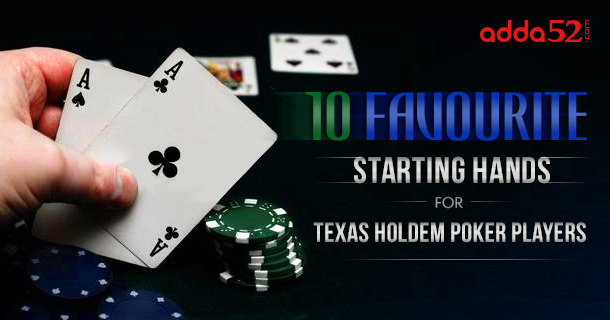Winning Texas holdem players do a good job of choosing the correct hands to enter the pot with. They resist the urge to enter the pot with marginal or poor hands, and always consider their position before making a decision to call, raise, or fold before the flop.
The strength of your starting hand in Texas Hold'em can help you determine your chances of winning, even before the remaining cards are dealt. From a pair of aces — the strongest starting hand — to a 2 and a 7, knowing the strength of your starting hand is an important part of your success at the table. Texas Holdem Heads-Up Preflop Odds. This table was created by enumerating through every possible board and opponent hole card combination for each of the 169 texas holdem preflop starting hands.
I remember when I started playing Texas holdem, I quickly learned how important starting hand selection was. The problem was that I couldn't find specific information about what hands to play and which hands not to play in this version of casino poker gaming.
Of course, you can find a short list of hands you can always play, and it's fairly easy to put together a list of some hands you should never play. But what do you do about all of the hands in between? It's still almost impossible to find a list of specific hands you can play.
I'm going to give you a specific list of hands to play in Texas holdem. But you also need to understand a few things before you just blindly use this list. It's important that you read the two sections below before reading the list.

How the List Was Developed
Over the years, I've developed the list of starting hands listed below. The hands I consider playing are based on table position. But I never play all of the hands blindly. The list is just the first thing I consider, and it's only a small part of what you need to consider also.
Most poker players play too many hands, and one of the fastest ways to improve your results is to play fewer hands. If you fold all the hands that aren't on the list, you won't enter the pot often with hands that lose in the long run.

I learned that the optimal percentage of hands for me to see the flop with is around 20%. This is somewhat game-specific because, in some games, I can push the percentage up to close to 25% and in others, I push it down closer to 15%.
The starting hand recommendations below will see the flop from 20% to 25% of the time, including the blinds. As you're going to learn, some of the hands are marginal and should only be played in certain situations. If you're in doubt about a marginal hand, the best play is to fold before the flop.
Starting Hand Warning
If you want to be a winning Texas holdem player, you must learn about position and how to use it to help you make profitable plays. It's much deeper than this, but as a short explanation, you can play more hands in late position than early position.


The reason is because you have an advantage when you get to act after your opponents. When you have to act first, your opponents have an informational advantage over you. This is why you can only play your strongest starting hands from early position.
The list below is just a starting point. Once you see the flop, you have to make smart decisions based on your position, the strength of your hand, and your odds of improving your hand. Most of the hands you see the flop with should be folded in order to save money for when you hit a good flop.
You also need to learn how to judge the abilities of your opponents. Against poor competition, you can get away with playing a few more hands because they make more mistakes. But against good competition, you can't afford to make mistakes because they make you pay for every mistake.
Early Position Hands
At a nine or 10-player table, early position is the first three seats to the left of the blinds. At a six-player table, it's the first two seats to the left of the blinds.
You can play a few more hands at short hand tables, but you shouldn't add too many more hands.
Here are the only hands to consider playing from early position:
- AA
- KK
- AKs
- AK
- AQs
I know this is a small list, but you're at such a strong disadvantage in early position that you must remain tight to have a chance to profit. And even though this list is small, in some games, I fold AQs from early position. Though it's rare, I've also folded AK from early position in particular games.
When you enter the pot from early position with these hands, you need to raise over 90% of the time. Playing in an aggressive manner forces weaker hands that can outdraw you on some flops to fold or pay a higher price to see the flop.
You also need to learn how to play each of these hands correctly after the flop. If you raise with QQ and the flop has an ace, you're in a weak position on the flop. If you enter with AKs or AK and the flop doesn't have an ace or king, you're also in a tricky spot.
Middle Position Hands
Middle position is the two or three seats to the left of early position. The list of hands you can consider entering the pot with include the hands in the previous section as well as the following hands:
- JJ
- 10 10
- 99
- 88
- 77
- AQ
- AJs
- AJ
- A10s
- A10
- A9s
- KQs
- KJs
Some of these hands are weaker than others and must be folded when you face a raise from early position. In most games, the only hands on this list I consider laying when facing an early raise are the pairs. And if I don't flop a set, I usually fold them after the flop.
Late Position Hands
Late position is the button and one seat to the right of the button.
The following list of hands can be played from late position in most games, but many of them must be folded if there has been a raise in the hand.
- 66
- 55
- A8s
- A7s
- A6s
- A5s
- A4s
- A3s
- A2s
- KQ
- KJ
- K10S
- K10
- QJs
- QJ
- Q10s
- Q10
- J10s
None of these hands are good enough to win on their own very often, so you need to be prepared to fold them on the flop if you don't improve. When you flop a draw to a good hand, you need to start using pot odds and expected value to make all of your post flop decisions.
With one of the hands in this section, you can raise occasionally, but most of them are drawing hands so you want to see the flop as cheaply as possible.
Blind Hands
The blinds are a big problem for most Texas holdem players. They get in trouble on the flop when they get to see the flop for free, or they decide to call a half bet or a raise with a weak hand because they already have money in the pot.
In the small blind, you need to fold any hand that isn't on the list above. It doesn't matter that you have a half bet in the pot already. The only hands you can consider playing from the small blind are the small pocket pairs not on the list, and it's questionable if these are worth playing for a half bet.
Any time you face a raise in the blinds, the only hands you should play with are the ones that are strong enough to play from early position and the pocket pairs that can flop a set. All other hands should be folded.
Once you see the flop from the blinds, always remember that you're in the worst position at the table. This means that if you don't flop a strong hand or a draw that offers the correct pot odds to chase, you should check and fold to the first bet. It's not worth chasing anything questionable from the blinds.
Conclusion
Now you have a specific list of starting hands for Texas holdem. You need to learn to make adjustments to the recommendations above based on whether the game is limit or no limit and based on the level of competition at the table. Use this list as a starting point and refine it as you gain experience.
Shoot for seeing somewhere around 20% of the flops, and you're going to have a better chance to win than most of your opponents. The player entering the pot with the strongest hand has the best chance to win.
Texas Holdem Starting Hands
One of the basics of Texas Hold'em is understanding card strength
One of the key aspects of winning a game of poker is to be able to make the most correct decisions as often as possible; therefore, selecting the hands you will go to war with is among the first steps. Making the decision whether to move forward with the hand you got is one of the most frequent ones to make during a game of Texas Hold'em. To succeed at this is not only important to know what hands to play or to fold, but also to know why it is done so, when you face a complex situation, you have a solid base to make the best decision. The first step would be to know the best and worst hands you could get.

How the List Was Developed
Over the years, I've developed the list of starting hands listed below. The hands I consider playing are based on table position. But I never play all of the hands blindly. The list is just the first thing I consider, and it's only a small part of what you need to consider also.
Most poker players play too many hands, and one of the fastest ways to improve your results is to play fewer hands. If you fold all the hands that aren't on the list, you won't enter the pot often with hands that lose in the long run.
I learned that the optimal percentage of hands for me to see the flop with is around 20%. This is somewhat game-specific because, in some games, I can push the percentage up to close to 25% and in others, I push it down closer to 15%.
The starting hand recommendations below will see the flop from 20% to 25% of the time, including the blinds. As you're going to learn, some of the hands are marginal and should only be played in certain situations. If you're in doubt about a marginal hand, the best play is to fold before the flop.
Starting Hand Warning
If you want to be a winning Texas holdem player, you must learn about position and how to use it to help you make profitable plays. It's much deeper than this, but as a short explanation, you can play more hands in late position than early position.
The reason is because you have an advantage when you get to act after your opponents. When you have to act first, your opponents have an informational advantage over you. This is why you can only play your strongest starting hands from early position.
The list below is just a starting point. Once you see the flop, you have to make smart decisions based on your position, the strength of your hand, and your odds of improving your hand. Most of the hands you see the flop with should be folded in order to save money for when you hit a good flop.
You also need to learn how to judge the abilities of your opponents. Against poor competition, you can get away with playing a few more hands because they make more mistakes. But against good competition, you can't afford to make mistakes because they make you pay for every mistake.
Early Position Hands
At a nine or 10-player table, early position is the first three seats to the left of the blinds. At a six-player table, it's the first two seats to the left of the blinds.
You can play a few more hands at short hand tables, but you shouldn't add too many more hands.
Here are the only hands to consider playing from early position:
- AA
- KK
- AKs
- AK
- AQs
I know this is a small list, but you're at such a strong disadvantage in early position that you must remain tight to have a chance to profit. And even though this list is small, in some games, I fold AQs from early position. Though it's rare, I've also folded AK from early position in particular games.
When you enter the pot from early position with these hands, you need to raise over 90% of the time. Playing in an aggressive manner forces weaker hands that can outdraw you on some flops to fold or pay a higher price to see the flop.
You also need to learn how to play each of these hands correctly after the flop. If you raise with QQ and the flop has an ace, you're in a weak position on the flop. If you enter with AKs or AK and the flop doesn't have an ace or king, you're also in a tricky spot.
Middle Position Hands
Middle position is the two or three seats to the left of early position. The list of hands you can consider entering the pot with include the hands in the previous section as well as the following hands:
- JJ
- 10 10
- 99
- 88
- 77
- AQ
- AJs
- AJ
- A10s
- A10
- A9s
- KQs
- KJs
Some of these hands are weaker than others and must be folded when you face a raise from early position. In most games, the only hands on this list I consider laying when facing an early raise are the pairs. And if I don't flop a set, I usually fold them after the flop.
Late Position Hands
Late position is the button and one seat to the right of the button.
The following list of hands can be played from late position in most games, but many of them must be folded if there has been a raise in the hand.
- 66
- 55
- A8s
- A7s
- A6s
- A5s
- A4s
- A3s
- A2s
- KQ
- KJ
- K10S
- K10
- QJs
- QJ
- Q10s
- Q10
- J10s
None of these hands are good enough to win on their own very often, so you need to be prepared to fold them on the flop if you don't improve. When you flop a draw to a good hand, you need to start using pot odds and expected value to make all of your post flop decisions.
With one of the hands in this section, you can raise occasionally, but most of them are drawing hands so you want to see the flop as cheaply as possible.
Blind Hands
The blinds are a big problem for most Texas holdem players. They get in trouble on the flop when they get to see the flop for free, or they decide to call a half bet or a raise with a weak hand because they already have money in the pot.
In the small blind, you need to fold any hand that isn't on the list above. It doesn't matter that you have a half bet in the pot already. The only hands you can consider playing from the small blind are the small pocket pairs not on the list, and it's questionable if these are worth playing for a half bet.
Any time you face a raise in the blinds, the only hands you should play with are the ones that are strong enough to play from early position and the pocket pairs that can flop a set. All other hands should be folded.
Once you see the flop from the blinds, always remember that you're in the worst position at the table. This means that if you don't flop a strong hand or a draw that offers the correct pot odds to chase, you should check and fold to the first bet. It's not worth chasing anything questionable from the blinds.
Conclusion
Now you have a specific list of starting hands for Texas holdem. You need to learn to make adjustments to the recommendations above based on whether the game is limit or no limit and based on the level of competition at the table. Use this list as a starting point and refine it as you gain experience.
Shoot for seeing somewhere around 20% of the flops, and you're going to have a better chance to win than most of your opponents. The player entering the pot with the strongest hand has the best chance to win.
Texas Holdem Starting Hands
One of the basics of Texas Hold'em is understanding card strength
One of the key aspects of winning a game of poker is to be able to make the most correct decisions as often as possible; therefore, selecting the hands you will go to war with is among the first steps. Making the decision whether to move forward with the hand you got is one of the most frequent ones to make during a game of Texas Hold'em. To succeed at this is not only important to know what hands to play or to fold, but also to know why it is done so, when you face a complex situation, you have a solid base to make the best decision. The first step would be to know the best and worst hands you could get.
The best hands typically include the highest possible pairs like A-A, K-K, Q-Q, or J-J, which are already good so the pressure of improving their value down the road is not that much. These are made hands already and there is less chance of one of your opponents holding a higher pocket pair. Besides pairs, the next best thing will be to have suited A-K or A-Q, which have a good chance to become pairs once the community cards are there. They also have the potential to become high straights and the fact that they are suited gives you the possibility of getting the best possible flushes.
Texas Holdem Starting Hands Chart
On the other hand, there are some hands to stay away from. These are hands that are worthless unless something else happens on the board – they're not even worth showdown value on the river.
Hands like 7-2, 8-2, 7-3 and 8-3 off-suit won't really lead you to something great easily. It can, for instance, become a low pair. Having a low card with a high card also puts you at a disadvantage. When competing for the pot when both you and your opponent have pairs, a low pair won't give any added value.
The Venom is back with $7,000,000 GTD starting July 24th.
Texas Holdem Starting Hands To Fold Away
America's biggest poker site. Since 2001, ACR has broken industry records, including the Guinness World Record for the largest cryptocurrency jackpot in an online poker tournament. Roulette online, free spielen.
